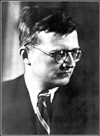
As a murderess, Katerina naturally arouses a complex response - yet, as Dr Tanner points out, such ambiguous characters are a fixture of 19th century Russian literature (Dostoyevsky, passim), as well as of post-war existentialist writing and much modern cinema. As Nicholas Till (Mozart and the Enlightenment) observes, even the morally didactic 18th century understood the role of protagonists like Katerina:
"For the rebels without cause of Sturm und Drang the problem was how the individual could maintain his personal integrity in a society that exerted all its powers to dispossess him of it. In many Sturm und Drang works an apparently criminal deed is seen as evidence of the possession of sincere emotion - the sign of a potentially great soul."
Shostakovich's avowed wish to present Katerina as "a positive personality" is partly accountable in terms of this tradition of alienated anti-heroes. Yet it is also clear that he identified passionately with her and did all he could to justify her, including caricaturing almost every other character in the opera. Why?
The answer lies in the context of the opera's creation (1930-32). Though David Fanning calls this period "one of the happiest of (Shostakovich's) life", he is contradicted by both Testimony and Lukyanova's biography. Moreover these sources are congruent with our knowledge of the Russian Cultural Revolution (1929-32), a chaotic interlude in which non-Party artists were, as part of a general drive against the bourgeois intelligentsia, violently persecuted. (See Chapter 2 of The New Shostakovich.) Surrounded as Katerina is by vicious, soul-destroying mediocrities similar to those who beset him during the opera's genesis, Shostakovich's identification with his beleagured heroine isn't hard to understand. Clearly he needed to let off some avenging steam; hence anyone who is no friend of hers - meaning everyone else in the opera - gets short shrift. (For several good reasons, the suggestion that he was here aiding Stalin's campaign against the peasants is risible.)
All of this, though, is of secondary importance to the composer's overriding wish to depict sexual love in a society which regarded it as anti-social. The sheer intensity of Katerina's passion, which must have struck a chord for the young Shostakovich during his fraught courtship of Nina Varzar, was unavoidably subversive - and it was this troublesome "individualism" which Stalin wanted to extinguish in 1936. (The idea that the dictator was puritanically shocked by the opera's sex scene is difficult to reconcile with a man who, during 1927, visited the Vakhtangov Theatre no less than eight times to inspect the half-naked prostitutes on display in Bulgakov's "pornographic" bordello drama Zoya's Apartment.)